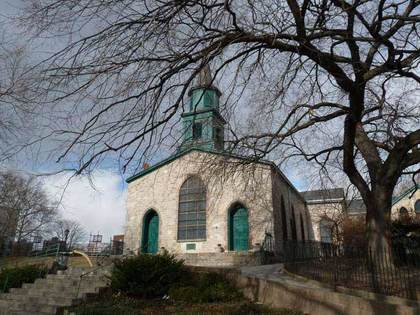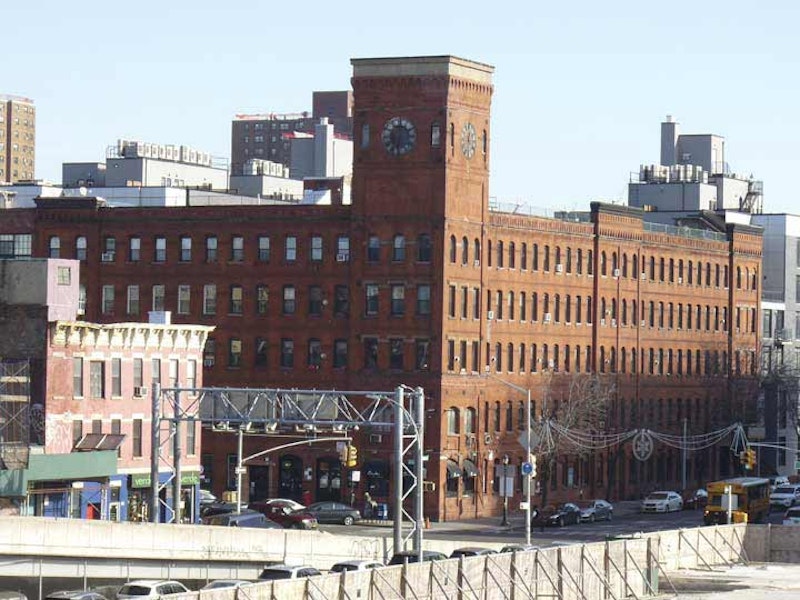Squeezed in between the Harlem River and Yankee Stadium in the southernmost Bronx is a small neighborhood known as Mott Haven, after Jordan Mott, who built a tremendously successful iron works beginning in 1828 (the iron works continued to 1906), centered along the Harlem River from about 3rd Ave. to E. 138th St. His handiwork can be still seen all over town on airshaft and manhole covers built by the Mott Iron Works. Mott bought the original property from Gouverneur Morris II in 1849; Morris was asked if he minded if the area was called Mott Haven, a name it quickly acquired. "I don't care... while [Mott] is about it, he might as well change the Harlem River to the Jordan." The iron works produced practical and ornamental metalwork used worldwide.
Patience and Fortitude, the two marble lions guarding the New York Public Library entrance at 5th Ave. and 42nd St., were sculpted right in Mott Haven, at St. Ann's Ave. and E. 142nd St., by the Piccirilli Brothers Monument Sculptors, whose family migrated here from Massa, Italy, in 1888. The firm also created the pediment of the New York Stock Exchange; Civic Virtue, the “scandalous” sculpture banished from City Hall Park to Kew Gardens, Queens in 1941, as well as Abe Lincoln at his Memorial in Washington. It's surprising that Mott Haven isn’t better known for the six Piccirilli Brothers, who were in business from 1893 to 1945. Attilio Piccirilli was the foremost artisan in the family (he executed the Daniel French portrait of Lincoln at the Memorial) and was on good terms with Enrico Caruso, Fiorello LaGuardia, and John D. Rockefeller. Teddy Roosevelt, William Howard Taft and Woodrow Wilson, paid a call to the Piccirilli Studios.
The Steinway piano factory across the East River may be better chronicled, but Mott Haven had the greater number of pianoforte manufacturers, enough that that the South Bronx was known as “The Piano Capital of the United States” prior to World War I. The Krakauer Piano and Estey Piano works (seen above), at E. 132nd St. between Lincoln and Alexander Aves. and Kroeger Piano at Alexander Ave., whose buildings are still standing, catered to a burgeoning piano-playing clientele in the days before radio and TV. These factories also produced player pianos. Krakauer supplied over 1000 pianos to New York City’s public schools until its Bronx factory closed in the mid-1970s. Estey, centered in Bluffton, Indiana, since 1869, built a marvelous clock-tower building at Lincoln Avenue and Bruckner Blvd. (then E. 133rd St.) in 1888.
The piano pioneer on the South Bronx had been the Arion Piano-Forte Company, built by George Manner and sold to J. Simpson and Company who moved it to 3rd Ave. and E. 149th St. in 1872; which in turn sold to Estey in 1885. Other piano firms included Dunham and Sons, Denobrica, Stuyvesant, Dusinberre & Co., Haines Brothers, Newberry & Evans, and Jacob Doll & Co., who distributed Pianola piano rolls.

Developer Edward Bertine built several three-story yellow-faced brick townhouses between 1891 and 1895 on 414-440 and 415-425 E. 136th St., between Willis Ave. and Brown Pl., joining a number of earlier brownstone buildings. The “Bertine Block” is one of a number of Mott Haven blocks given over to eclectic residential architecture, most notably on E. 139th, E. 140th and E. 142nd between Willis and Brook Aves., many in Dutch/Flemish styles. E. 139th and E. 140th are in especially good shape, with distinctive stained glass and sculptural elements on some of the houses.

After opening in 1891, Alexander Ave. became known as Doctors Row and “Irish Fifth Avenue.” Some of the handsome buildings from its early days still stand, such as St. Jerome’s Church and attendant school, constructed in 1898 between E. 137th and 138th Sts., the row between E. 138th and 139th, and the neo-Renaissance Mott Haven Branch of the NY Public Library, built in 1905 by Babb, Cook and Willard.

St. Ann's Episcopal Church, St. Ann's Avenue between E. 139th and E. 141st Sts., is The Bronx' oldest church, built in 1841 and dedicated to Gouverneur Morris' mother Ann. Several of the Bronx’ most noted families of the colonial era and beyond are buried in the church's graveyard, including Gouverneur and Lewis. The church is surrounded by foliage and locked gates, so it's difficult to get a good look at it in summer. The best view in winter is from E. 139th St. Before much of Mott Haven was purchased by Jordan Mott for his iron works in the 1840s, Mott Haven was owned by the Morris family.
Lewis Morris (1726-1798) was an ardent supporter of American independence and served in the Continental Congress from 1775-1777, and in the NY state legislature between 1777 and 1790. He signed the Declaration of Independence in 1776.
Gouverneur Morris (1752-1816) half-brother of Lewis Morris, was a political leader, diplomat, U.S. Senator, and American ambassador to France. He was an outspoken opponent to what he termed “unchecked popular democracy.” His son, G. Morris II, sold the estate to Jordan Mott. Robert Morris (1802-1855), grandson of Richard Morris, was a three-term mayor of New York City from 1841 to 1844.

The eternal question for Bronxites is who was Major Deegan? This park oval at the west lane of the Concourse and E. 138th explains it. Major William Deegan (1882-1932) constructed Army bases in and around New York during World War I. He was a State Commander of the American Legion, a Commissioner of Public Housing, and a close friend of Mayor Jimmy Walker, who appointed him Commissioner of Tenement Housing in 1928. He died from complications after an appendectomy at 39.
The expressway named for Deegan was constructed in stages beginning in 1944. By 1956 the road reached the Westchester county line, where it changes its allegiance to New York governor Thomas E. Dewey and runs north and west to Buffalo; motorists know it best as the New York State Thruway. Dewey, a Republican, was NY state governor between 1943 and 1955. He lost for President to Franklin D. Roosevelt in 1944, and ran unsuccessfully against Harry S Truman in 1948. Dewey was the last major-party presidential candidate from either party to wear a mustache.

I have an attraction to the Art Deco and Moderne architectural designs that first appeared in the 1920s and then dominated the scene in the 1930s, not only for their clean, streamlined appearance, then a novelty, but for the lettering and graphic style so frequently employed on their façades.
The Bronx Terminal Market was built in the John Hylan administration in the 1920s. Since then it's been a receiving point for the city's fruits and vegetables (though much of that has moved to Hunts Point in recent decades). It stretches along the Deegan between E. 149th St. and the Macombs Dam Bridge near Yankee Stadium. During Mayor LaGuardia's tenure it was expanded and attracted more tenants, and the distinctive white building with the “Bronx Terminal Market 1935 City of New York” dates to the Little Flower’s era. The Market was in danger of closure in the early-2000s, but hopefully this building will remain.

When I first crossed the 145th Street Bridge, which connects W. 145th St. in Harlem with E. 149th St. in the Bronx (the Bronx shares Manhattan’s east-west street system, though the streets do not exactly match up across the Harlem River) I was immediately taken by the pedestrian sidewalk lighting. As late as the mid-1990s, the walks were illuminated by incandescent bulbs with “crinkled” radial-wave diffusers, suspended from ornate, cast-iron shafts. A testimony, probably, to the lack of use the walkway got in the overnights. The old lamps have been updated. Another set of cast-iron masts holds an old sign reading “All persons must leave the draw when gong sounds.”
The 145th, as well as its sister swing bridges over the Harlem River, the Willis Avenue, the Third Avenue, the Madison Avenue, the Macombs Dam and the University Heights Bridge, were all constructed in the same era, between 1895 and 1910, with the 145th St. Bridge opening in 1905. They can all swing perpendicularly to allow ship traffic in the Harlem River to pass, with hydraulic machinery controlled from an operator’s house. In 2004, The Third Avenue Bridge was being replaced with a $119 million replacement that will resemble the previous span built in 1898.
The 145th Street Bridge is considered by some critics as less successful, in an esthetic sense, then the Macombs Dam Bridge, the first of the bunch, that opened in 1895. All are beautiful bridges: New York City, located by two major rivers and hundreds of smaller rivulets and creeks, has more than its share of opportunities for attractive bridge engineering. Most Harlem River Bridges of the 19th and early-20th century were designed by architect Alfred Pancoast Boller and share design elements.
—Kevin Walsh is the webmaster of the award-winning website Forgotten NY, and the author of the books Forgotten New York (HarperCollins, 2006) and also, with the Greater Astoria Historical Society, Forgotten Queens (Arcadia, 2013)

